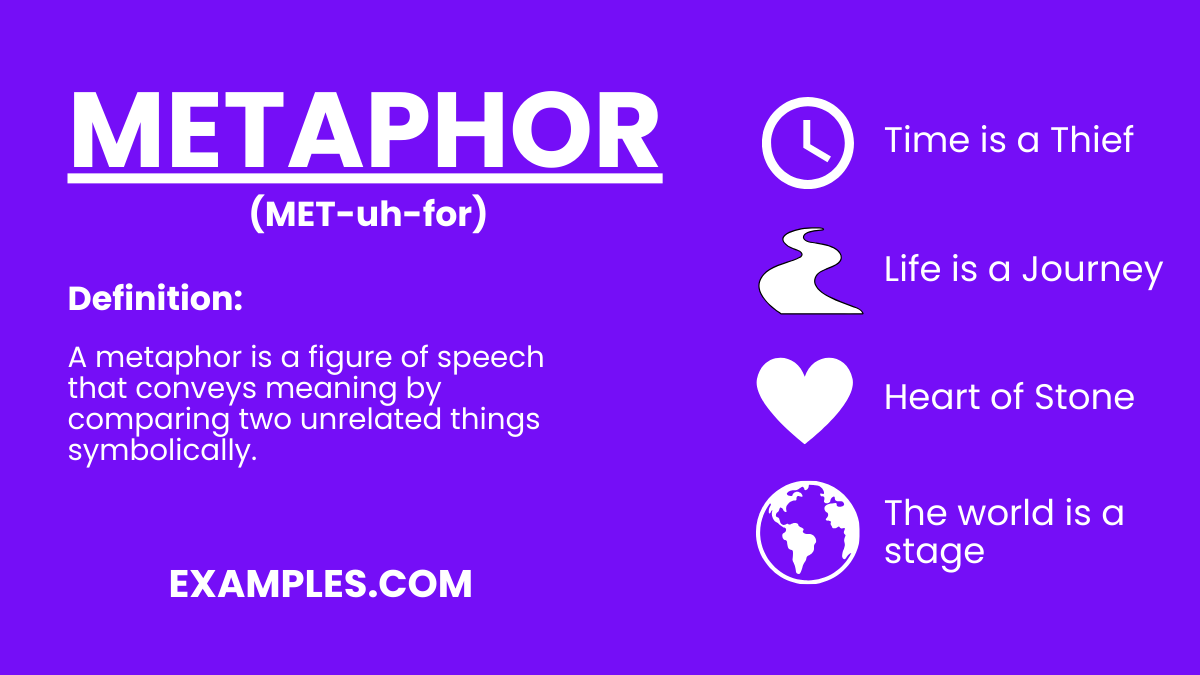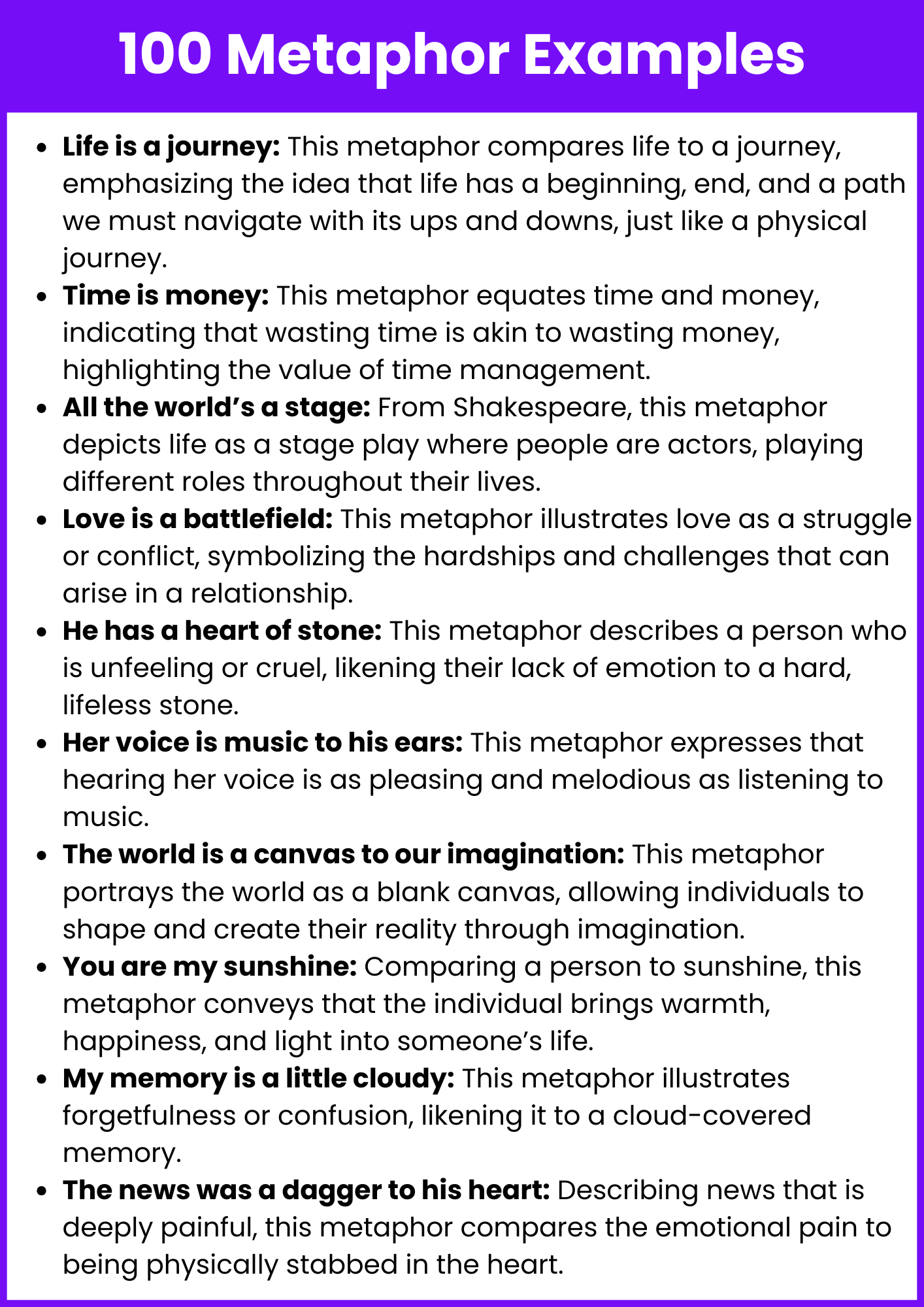Metaphor
What is Metaphor? – Definition
A metaphor is a way of describing something by saying it is something else that has similar qualities. It’s not meant to be taken literally but helps to create a vivid image or make a point.


Download Metaphor Examples
Enhance your understanding with our comprehensive PDF guide.
Download PDFExamples of Metaphors
- My mom has a heart of gold.
- My friend’s sister is a night owl.
- My hands were icicles because of the cold weather.
- He has a stone heart.
- She was an autumn leaf.
- Time is a thief.
- The world is a stage.
- Her voice is music to his ears.
- He is the black sheep of the family.
- Life is a rollercoaster.
- He is a lion when he comes to the field.
- She is such a firecracker.
- His smile was a ray of sunshine.
- Her words were a burning fire.
- He has a head full of clouds.
- The camera was his eye.
- The clock ticked away life’s moments.
- The mirror reflects the soul.
- The road ahead was unclear.
- The sunset was a beautiful end.
- His mind is a steel trap.
- The city is a jungle.
- The classroom was a zoo.
- Her smile was the sun.
- Life is a dance.
- Life is a journey through uncharted waters.
- She was an anchor in the storm.
- His eyes were windows to his soul.
- She was a mountain of patience.
- His temper was a lightning bolt.
Types of Metaphors
How to Identify/Find Metaphor?
To identify metaphors, look for phrases that describe one thing in terms of another without using “like” or “as”. Metaphors often highlight similarities between unrelated subjects, creating a vivid image or conveying deeper meaning.
- Look for direct comparisons that imply one thing is another.
- Identify words or phrases that create strong imagery.
- Check if the comparison enhances the understanding of the subject.
- Notice if the comparison adds emotional or descriptive depth.
- Look for metaphors that are integral to the theme or message.
How to Use Metaphor?
Use metaphors to enhance your writing by making comparisons that reveal new insights or add emotional depth. Ensure your metaphors are clear and relevant to the subject, avoiding mixed or clichéd expressions for greater impact.
- Choose comparisons that resonate with your audience.
- Use vivid and specific imagery to make your metaphor stand out.
- Integrate metaphors seamlessly into your narrative or argument.
- Ensure the metaphor enhances the reader’s understanding or emotional response.
- Avoid overusing metaphors to maintain their effectiveness.
Other Metaphor Examples
Explore Other Literary Devices
Elevate Your AP English Preparation
Unlock your potential with our comprehensive AP English exam preparation tools designed to help you excel.
- Extensive Question Bank: Access 900+ exam-like questions for both AP English Language and Literature.
- Expertly Crafted: Questions mirror the structure and difficulty of actual AP exams, ensuring relevant practice.
- Detailed Explanations: Understand your mistakes with clear, concise breakdowns of correct and incorrect answers.
- Personalized Learning: Tailor your study sessions with topic-specific tests and adaptive learning tools.
- Comprehensive Coverage: Master all aspects of the AP English curriculum with extensive guides and resources.
Frequently Asked Questions
-
What is a metaphor?
A metaphor is a figure of speech that directly compares two unrelated things by stating one is the other, enhancing understanding or creating vivid imagery. -
How does a metaphor differ from a simile?
Unlike similes, which use “like” or “as” for comparisons, metaphors state that one thing is another, creating a more direct and impactful connection between the two. -
Why are metaphors important in writing?
Metaphors enrich writing by adding depth and creativity, making descriptions more engaging and helping readers visualize concepts more vividly and emotionally. -
Can metaphors be extended?
Yes, extended metaphors continue the comparison throughout a passage or an entire work, providing a more comprehensive and elaborate connection between the compared elements. -
How can I effectively create my own metaphors?
To create effective metaphors, identify the essence of what you’re describing, find an unrelated concept with similar qualities, and express the comparison in a clear, imaginative way.

